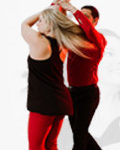Most skills require balancing between two extremes.
A proper anchor involves keeping your unit foot behind the other foot without placing the unit foot way behind your body, body rolls require some movement but look sloppy if they are too big, and so forth.
In these examples, you are trying to hit a fairly narrow target of “just right,” without going too far to one extreme or the other.
Learning west coast wing with overcorrection
Because the target is such a narrow range of options within the whole spectrum of the movements you could make, it is much easier to approach the ideal by deliberately overshooting and then bringing yourself back towards the target.
This method of learning was recognized as early as the ancient Greeks:
Aristotle uses this method of training when describing how an individual should attempt to acquire the moral virtues!
By intentionally overshooting the ideal state, one can slowly close in on the target by making smaller corrections every time one overshoots the mark.
This same principle is behind the tuning procedures of many professional musicians, who will deliberately aim below the note they want and then bring the pitch up until they have tuned their instrument correctly.
For any dance skill, ask yourself what it would take to overdo it?
It might be a full-body roll that looks like a parody, a truly ridiculous degree of foot turnout, or a massively overdone smile.
Go to the extreme, and then tone it back until you hit the target and you’ll be getting good at west coast swing fast!



 Brian & Megan
Brian & Megan